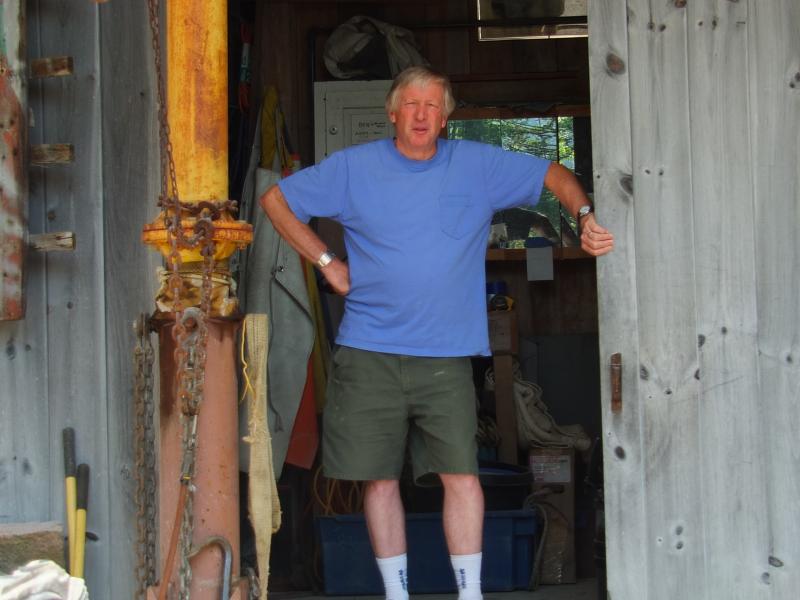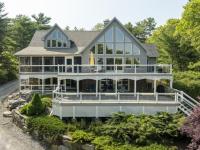Sculpture for art's sake
 BILL ROYALL stands in the entrance of his studio in Southport. SUZI THAYER/Boothbay Register
BILL ROYALL stands in the entrance of his studio in Southport. SUZI THAYER/Boothbay Register
 BILL ROYALL stands in the entrance of his studio in Southport. SUZI THAYER/Boothbay Register
BILL ROYALL stands in the entrance of his studio in Southport. SUZI THAYER/Boothbay Register
Bill Royall has a home on the coast of Maine with sprawling lawns that extend to the water's edge, a wife who is his best friend (and, he says, the reason he is where he is today), and a lot of granite.
Royall was living in Kingfield 38 years ago making brass belt buckles and small metal sculptures. Then he moved to Bowdoinham, where he built a 16-foot by 24-foot cabin to live in.
That cabin was moved and now occupies a section of the second floor of his home on Pratt's Island. It has been altered to fit the overall design of the house that he now shares with his wife, Emery.
As enticing as the view of the ocean and the gardens and the sprawling lawn are, what commands attention are the sculptures.
They're all granite. They're big. It's hard to not look at them.
Royall said it's more important that his work is viewed than sold, and that it gets people’s attention.
“I've been carving stone since I was 17,” he said. “If you stay in a niche for a long time, you kind of burrow into it and you want to keep experimenting and see what works. It takes a long time to discover what you want to do.”
“I've been lucky because I have this business, ‘Maine Millstones.’ I'm one of the few people in the country who make granite millstones.”
This, along with his bronze belt buckles and silver bracelets, which he makes during the winter in Wyoming, helps support his art. It also allows him to do the type of art that he loves, as opposed to pumping out sculptures that he knows would sell.
“If someone wants to see my work they're welcome to come here and see it,” Royall said. “I'm just not into selling in galleries. If your motivation is to sell, then you do what sells.”
Several of the smaller pieces that grace the Royalls’ home were experiments.
Royall has learned that polishing a section of the stone to a high gloss makes that part of the stone darker. “One of the things I've figured out, through experimenting, is you can't fight the light,” he said. “But you can enhance the natural beauty of it by making the shadows darker.”
Royall said he's been through a lot of changes in his work.
“When I stand back and get analytical, I see in the last 10 to 15 years a body of work that really reflects the environment,” he said. “When I look at six to eight pieces (made in succession) I see that there is a theme. That's not something you plan.”
At a special dedication ceremony last year, one of Royall's larger pieces, “The Storm,” was presented to the Viles Arboretum in Augusta, a park of trees and botanical gardens, by Elsie Viles, in memory of her late husband.
Toward the end of the day a conversation between Royall and Arboretum Executive Director Mark DesMeules sparked an idea. The next week Royall returned with fellow sculptors Dan Ucci and Andreas von Huene.
Within six weeks they had installed the first sculpture foundation and the beginning of the largest outdoor sculpture park in Maine. Royall said it is a destination for viewing some of the most important sculpture in Maine. Today 20 sculptures by 15 artists line the sculpture trail.
And with a steady stream of visitors to appreciate them, it's the perfect venue for Royall's sculptures.
“I want my art in a public place that commands attention,” he said. “It gets seen at places like the arboretum ....”
A lot of artists say they don't care if their art sells, that the biggest reward comes in the act of creating. But when Royall sells one of his creations, he said he feels validated. For him, it is as rewarding to sell a belt buckle or bracelet as it is to sell one of his large sculptures.
“I'm glad somebody likes it,” he said.
Event Date
Address
United States



























